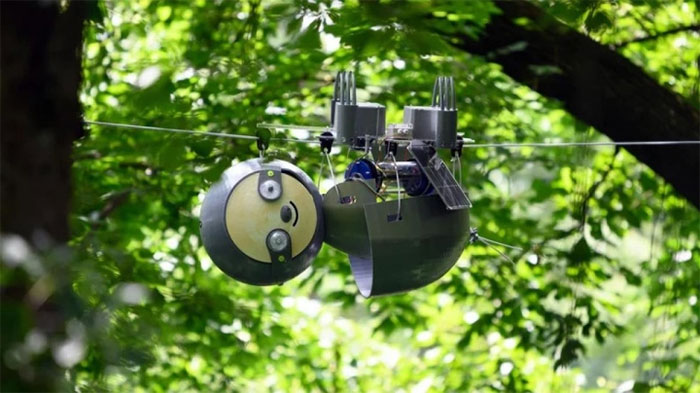As one of the slowest and “laziest” robots in the world, SlothBot, despite being stationary, is contributing to the preservation of biodiversity.
When discussing solutions to urgent environmental concerns such as deforestation, mass extinction, or climate change, people often think big: scientists striving to create electric aircraft, drought-stricken nations calling for artificial rain… The world is facing a series of ecological issues on a large scale, and thus, comprehensive, rapid, and large-scale solutions are more anticipated than ever.
However, instead of “going big,” Georgia Tech proposed a more modest, smaller, and slower solution. While it may sound completely useless, this solution is showing many positive results.

The machine designed with features resembling a sloth.
Last year, the Georgia Institute of Technology in the U.S. completed the research and development of SlothBot – a robot modeled after a sloth. This machine reportedly spent 13 months slowly crawling through the canopy of the Atlanta Botanical Garden, attracting visitors and collecting data.
Previously, the “father” of the machine, Mr. Magnus Egerstedt, revealed that he came up with the idea of creating a sloth robot when he first encountered the animal in Costa Rica. “I didn’t understand why they were so slow despite the constant dangers around them,” Magnus Egerstedt shared.
Sloths in the wild spend up to 15 hours a day sleeping, and even when awake, they only move around at a “turtle’s pace” of about 150 meters per hour. On average, each sloth only travels about 50 to 100 meters a day.
Inventor Magnus Egerstedt “took slowness as a design principle” to create SlothBot. This unique sloth robot is equipped with solar panels and advanced energy management technology, and while it may be “lazy” in movement, SlothBot has its own mission: to observe and gather important information about weather, water levels, and carbon monoxide levels within its expansive 121,000 square meter territory. Additionally, SlothBot has survived for over a year, significantly longer than the few months anticipated by its creative team at Georgia Tech.
In summary, something that may sound “silly” like an artificial sloth could actually represent the foundation for future low-energy, long-term solutions capable of addressing the severe devastation caused by humans.
When exploring solutions like SlothBot, one of the most common keywords encountered is “biomimicry.”
Nature magazine defines biomimicry as “the synthesis of materials, synthetic systems, or machines that function to imitate biological processes.” In other words, “biomimicry” is a technical philosophy that mimics biological systems.

SlothBot is one of the examples of the biomimicry design trend.
It may sound distant, but in reality, biomimicry has long infiltrated various aspects of life. According to the U.S. Library of Congress, Velcro is a classic example of biomimicry, mimicking the hooks on plant burrs from the 1950s. The famous aircraft manufacturer Airbus once planned to develop a passenger aircraft using gas and electricity based on the characteristics of predatory birds with adjustable “feathers.” According to the American Society of Mechanical Engineers, there is a widely used surgical adhesive that employs a bonding structure based on gecko feet. These are just a few of the many instances of biomimicry applied in practice.
According to Georgia Tech, biomimetic systems are particularly well-suited for conservation purposes. The design team created a robot based on the sloth because they wanted to deploy it in the ecosystem where sloths exist. SlothBot is about 1 meter long with a 3D-printed shell that helps protect the motor, components, battery, and sensors inside from weather impacts.
SlothBot is an ideal machine for collecting various types of climate and ecosystem data to support research and conservation of rare animal species, as there is already an animal in the ecosystem that shares similar characteristics. And whether you believe it or not, a robotic sloth is truly representing a new and quite effective way to observe threatened ecosystems by mimicking the animals that belong to those areas.


















































